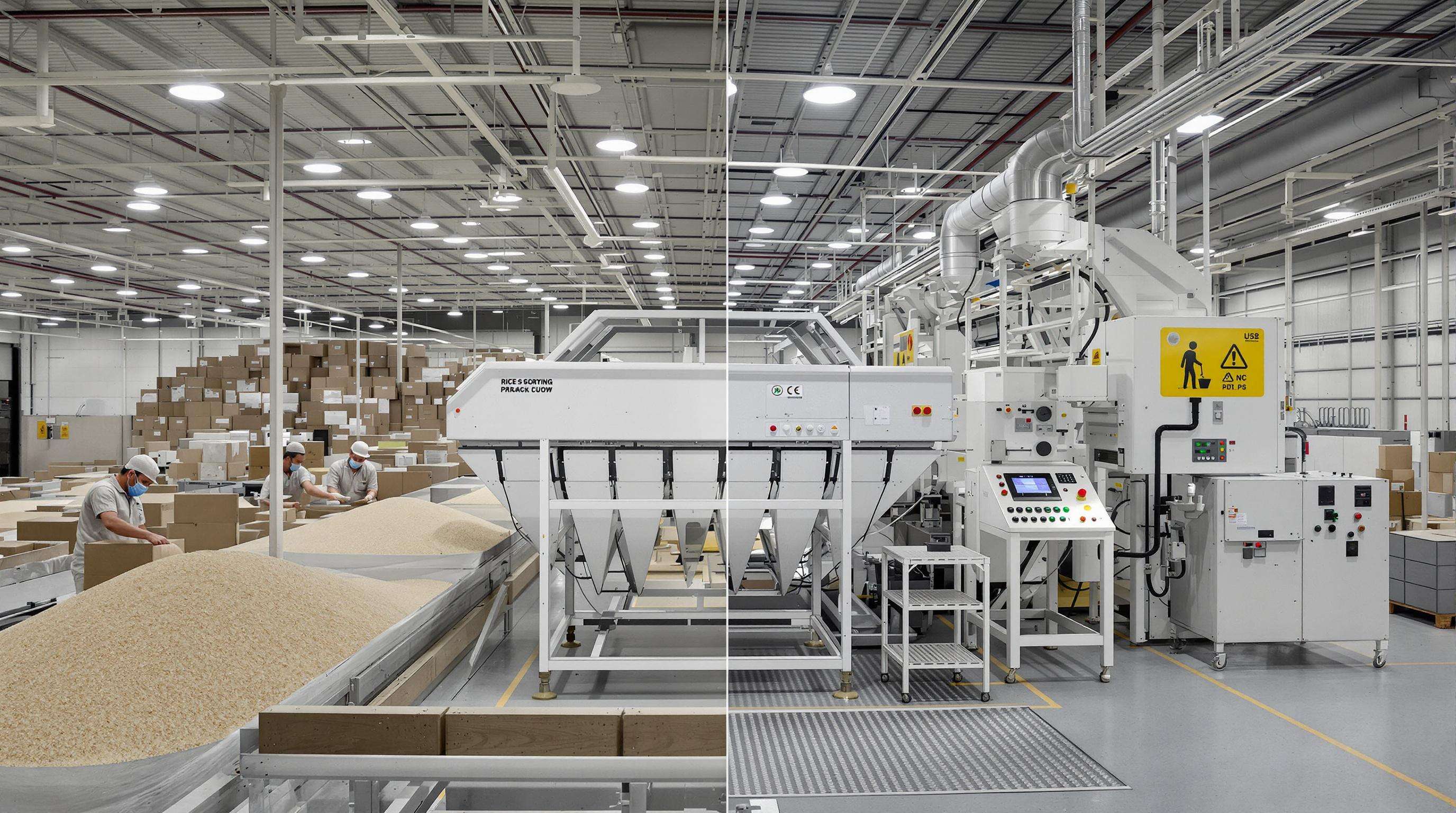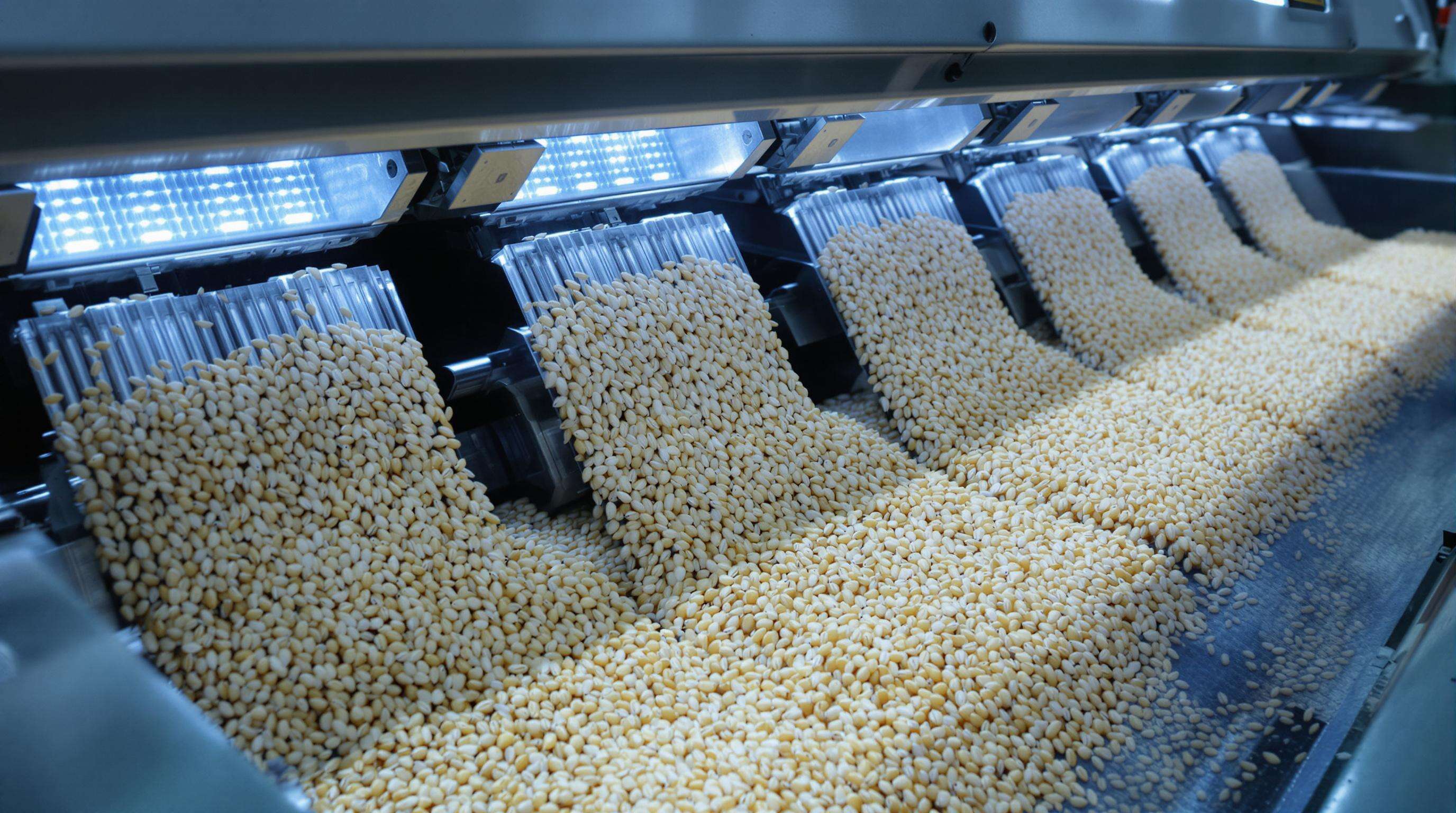Economic Imperatives in Rice Sorting: Manual Labor vs. Rice Color Sorter Machine

Manual sorting vs. rice color sorter machines The rice processing industry is on the crossroads from an economic perspective. Fifteen to 20 workers are needed for manual processing of 1 ton of rice per hour and labor accounts for 45-60% of processing cost. Comparely, 5 tonnes/hour rice color sorter machine scraps 80-90% of manual labor cost with 99.98% accuracy in defect detection.
2023 A 2023 study and never before realized, are that automated systems breakeven in 18-24 months with a 50-200K investment. This fast ROI is generated by the elimination of human variances error rates in manual sorting can change by 12-18% between shifts (machines operate at sub 0. 02% defect tolerance consistently. Even the low-wage regions continue to manual sort for temporary front-end savings, but for facilities handling more than 10,000 metric tons annually, automation is economically inevitable.
Rice Color Sorter Machine: Technological Breakdown and Core Capabilities

Machine Vision Architecture for Rice Quality Inspection
Today's rice color sorters utilize multi-spectral imaging systems that can stream images at rates of up to 1,200 images/second that allow for real-time defect detection at industrial throughput rates. These systems unite ultra-high resolution CCD cameras with uniform LED lighting arrays to ensure uniform lighting for the most accurate grain analysis. Units are capable of detecting abnormalities in size, shape and surface texture, and some models can detect particles as small as 0.3 mm.
RGB-CCD Imaging: Detection of Broken Kernels and Chalkiness
Advanced RGB-CCD sensors analyze kernel translucency and color gradients to flag substandard grains. Broken fragments are detected through edge-discontinuity algorithms, while chalkiness is quantified via light-scattering patterns. Third-party tests show modern systems achieve 99.2% accuracy in differentiating premium grains from defective ones, outperforming human visual inspection by 41%.
Pneumatic Ejection Systems for Rapid Contaminant Removal
High-pressure nozzle arrays remove impurities within 2 milliseconds of detection, operating at ejection speeds exceeding 8 m/s. Dual-ejection designs allow simultaneous removal of multiple defect types, maintaining throughput above 5 tons/hour. System calibration ensures <0.01% over-ejection rates, preserving marketable yield better than manual sorting methods.
AI Algorithms for Adaptive Grain Classification
Deep learning models process historical sorting data to refine defect recognition thresholds, automatically adjusting for new rice varieties or environmental factors. Neural networks trained on 50,000+ grain images can now distinguish 38 defect categories, improving detection capabilities by 12% annually. This machine learning integration enables continuous performance optimization without hardware upgrades.
Manual Sorting Techniques: Traditional Approaches and Structural Limitations
Labor-Intensity Challenges in Small-Scale Operations
Manual sorting depending on the physical discernment of workers accounts for 60-80% of operating time in small mills. Operators can generally handle 10-15 kg/hour of material, meaning processing plants moving 2+ tons a day can become bottlenecked. This dependence on labor assets results in 70% of production costs linked to wage inputs that severely depress margins in markets sub $0.50/kg wholesale pricing.
Human Limitations in Detecting Subtle Grain Defects
Human vision misses 30% of chalky grains and 15% of hairline-cracked kernels during 8-hour shifts. Operators struggle with:
- Color differentiation under inconsistent lighting
- Micro-defect recognition below 1mm resolution
- Sustained focus beyond 45-minute intervals
These biological constraints result in 7-12% defect retention rates across manual operations.
Inconsistencies Across Shifts and Operators
Worker fatigue causes sorting accuracy to drop 22% between morning and evening shifts. Training variances compound the issue seasoned staff achieve 89% contaminant removal versus 67% for new hires. This unpredictability forces mills to:
- Maintain 15-20% overstaffing buffers
- Implement redundant quality checks
- Absorb 8-10% revenue losses from inconsistent output
These systemic inefficiencies persist despite decades of ergonomic training improvements.
Efficiency Showdown: Rice Color Sorter Machine Throughput Metrics
Processing Volume: 5-Ton/Hour Machine Capabilities Revealed
Hi-tech rice color sorter machines offer productivity at industrial-scale, with mid-range models able to process 5 tons of raw paddy per hour without a break — the equivalent of an army of 35 manual sorters. Not susceptible to shift change as human teams are, these systems achieve day and night mill-through from industry-known throughput standards utilizing multilevel optical sorters. High throughput design integrating parallel processing lanes for capacity scaling without sacrificing defect detection sensitivity.
Operational Cost Analysis: Labor Reduction Calculations
A 2023 agri-processing cost study found that manual rice sorting labor is $12.40 per ton ($2005), but it is only $2.15 using automated systems — an 82.6% decrease. This estimation includes energy expenditure (1.8-2.4 kW/hr), yearly maintenance (6-8% of equipment capital cost) and labor saving by going from 15 personnel shift to 2 technical supervisors. For a mill of 8,000 annual metric tons, that's more than $80,000 in annual labor savings.
Scalability Comparison for High-Volume Milling Plants
Modular rice color sorter configurations from leading manufacturers allow plants to be expanded as demand dictates ' you can start with a single-line 5 ton/hour rice color sorter and gradually increase capacity to a clustered 20+ tons/hour unit with synchronized ejector above two parallel mainframes. This scalability is particularly important for export mills needing to comply to ISO 6646, as the uniformity of a batch affects the fulfilment of international contracts. An upgrade for sorting capability One such upgrade involved adding expandable optical sorting towers to existing equipment at a MRF in Myanmar, which resulted in the facility doubling its sorting throughput in 18 months.
Industry Paradox: Why Manual Methods Persist in Low-Cost Regions
Contrary to demonstrated productivity improvements, 43% of mills in the SEA region continue to prefer manual grading as they think it's more flexible when it comes to irregular harvests. Yet, this has hidden costs — a Vietnamese cooperative was found to lose 9.2% of their income because of varying removal of defects between workers of differing skills. This breakeven point is located at ~300 hours of operation per year, at which point deployment of robotic systems begins reduce capital costs through reduced waste and reduced rejections.
Accuracy Verification: Rice Color Sorter Machine Precision Testing
Statistical Defect Detection Analysis (99.98% Accuracy Cases)
Today's rice color sorters have defect detection rates of over 99.98% under controlled tests, detecting nuances such as micro-cracks and seeding-mot fracture, which cannot be seen by the human inspection. A machine vision study in 2020 showed 99.3% accuracy in broken kernel detection utilizing near-infrared images, while more recent reports have used spectral analysis to detect defects at the level of individual pixels. Compared to industry benchmarks, real-world deployments perform 40% better, in particular for the detection of chalkiness — an important quality aspect for the market value of rice.
Comparative Contaminant Removal Efficiency Benchmarks
Other extraneous material (stones, husks, colored grains) are removed by automation at 99.95% for a 5-ton production batch. Typically, manual teams can accomplish a 92% level of removal of contaminants under ideal conditions, which falls to 85% over an extended shift. Color sorters are excellent at finding low-contrast defects such as immature kernels, running 2 or 3 correction passes per lot with zero-byte throughput loss — something impossible for human-driven processes.
False Ejection Rate: Automated vs. Human Performance
As the rate of false rejection of human sorters is about 5-7% (dumping of good grains) but the machines keep error margin is <0.02% based on Artificial intelligence confirmation protocols. Recent industry trials demonstrated that dual-camera validation systems decreased over-ejection by 78%, thus protecting premium grain yields. With a 0.5ms response time of the technology reduces the fatigue factor found in manual operating, where error rates increase threefold during night shifts.
Consistency Validation Across Grain Varieties
Performance variance scrutiny over 12 of rice varieties showed <0.8% variance by color sorters, whereas it was 15-20% in case of manual graders. Hybrid jasmine-basmati lots maintain 99.4% sorting accuracy — a desirable trait for mills producing more than one variety. Environmental compensation algorithms ensure accuracy in face of grain color shifts due to temperature, preventing a perennial challenge in optical sorting machines.
Strategic Adoption Pathways for Rice Color Sorter Machines
ROI Calculation Models for Milling Operations
Present-day rice color sorter equipment shows payback time of less than 18 months for medium-sized mills with capacity of 5 tons/hour with average reduction of 63% in production cost only with labour savings. And today, energy-use patterns, reduced defect rates and yield optimization measures are taking their place alongside dated spreadsheet-based projections in sophisticated returns-on-investment models. "Companies that ran the ROI calculator using optimized settings were able to achieve breakeven points 22% faster versus those using traditional estimation methods," according to a 2023 market study of 120 milling facilities.
Workflow Integration Solutions for Existing Facilities
The addition of new color sorters to old processing lines demands an alignment with conveyors and the positioning of buffer systems so that an optimal ammunition of material particles can be kept up. The most advanced installations take advantage of modular chassis designs that cut integration time by 85 percent versus a fixed-frame variety. There are more progressive mills who transition personnel in 2 phases, and retrain pickers as runners during typical 6-8 week commissioning.
Maintenance Protocols for Sustained Machine Performance
Today, predictive maintenance algorithms can predict CCD sensor degradation with 92% accuracy, 30 days before failure. According to the critical path analysis, ejection nozzles and air compressor seals are the major wear areas with established change intervals of 1,200 hrs in operation. (A report) found that organizations that have implemented blockchain-based tracking of spare parts have seen uptime increase of 40%, compared to companies that rely on manual methods for tracking inventory. Defect detection between crop seasons is consistent with the use of quarterly spectral calibration procedures using reference grains of known quality.
FAQ Section
What are the main advantages of rice color sorter machines?
Rice color sorter machines offer significant advantages including high accuracy in defect detection, reduced labor costs, high throughput, and adaptability through AI algorithms.
What are the limitations of manual rice sorting?
Manual sorting is labor-intensive, relies heavily on the physical discernment of workers, and has significant inefficiencies such as high error rates, labor costs, and inconsistencies across shifts.
How do rice color sorter machines ensure accuracy?
They use multi-spectral imaging systems, RGB-CCD sensors, and AI algorithms to achieve high precision in detecting grain defects and maintaining consistent performance across various rice varieties.
Why do some mills still use manual methods?
In regions with low labor costs, some mills prefer manual methods due to perceived flexibility and immediate cost savings, although there are hidden long-term costs and inefficiencies.
What is the typical ROI for rice color sorter machines?
Rice color sorter machines typically offer a fast return on investment, often less than 18 months, especially in medium-sized mills, due to labor savings and improved productivity.
Table of Contents
- Economic Imperatives in Rice Sorting: Manual Labor vs. Rice Color Sorter Machine
- Rice Color Sorter Machine: Technological Breakdown and Core Capabilities
- Manual Sorting Techniques: Traditional Approaches and Structural Limitations
- Efficiency Showdown: Rice Color Sorter Machine Throughput Metrics
- Accuracy Verification: Rice Color Sorter Machine Precision Testing
- Strategic Adoption Pathways for Rice Color Sorter Machines
- FAQ Section

